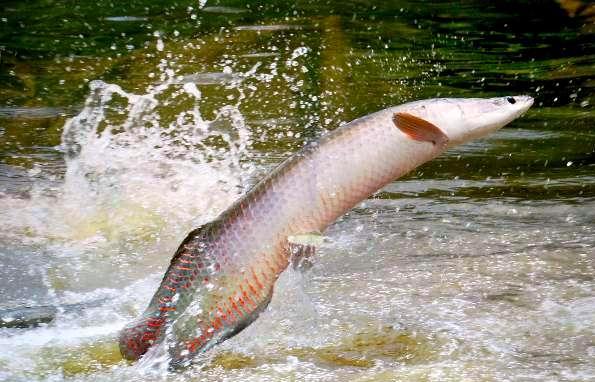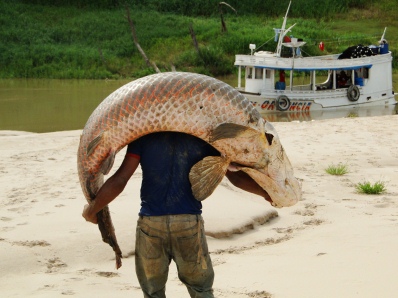Arapaima Gigas
It gets its name from the Indian Culture, Pira means Fish Rucum means RED.
Popular Name: Pirarucu
Scientif Name: Arapaima gigas.
Geographical Distribution: Found in the Amazon Region and the North of South America.
Habitat : It Lives in warm shalow waters of rivers and Lagoons.
Feeding : Eggs, fishes,shrimps,worms, snakes and crabs .
Reproduction : Arapaima's life cycle is greatly affected by seasonal flooding. Various pictures show slightly different coloring changes when they reproduce. The arapaima lays its eggs during the months when water levels are low or beginning to rise. They build a nest about 50 centimetres (20 in) wide and 15 centimetres (5.9 in) deep, usually in muddy-bottomed areas. As the water rises, the eggs hatch. Each female may lay around 180,000 eggs.
Morphology
The arapaima is torpedo-shaped with large blackish-green scales and red markings. It is streamlined and sleek, with its dorsal and anal fin set near its tail.
Arapaima scales have a mineralised, hard, outer layer with a corrugated surface under which lie several layers of collagen fibres. In a structure similar to plywood, the fibres in each successive layer are oriented at right angles to those in the previous layer, increasing toughness. The hard, corrugated surface of the outer layer, the soft but tough internal orthogonal collagen layers and the hydration of the scales all contribute to their ability to flex and deform while providing strength?a solution that allows the fish to remain mobile while heavily armored.
Arapaima can reach lengths of more than 2 m (6 ft 7 in), in some exceptional cases even more than 2.5 m (8 ft 2 in) and over 100 kg (220 lb). The maximum recorded weight for the species is 200 kg (440 lb), while the longest recorded length was 4.52 m (15 ft). As a result of overfishing, large arapaima of more than 2 m (6 ft 7 in) are seldom found in the wild.
Read More in: http://www.cpt.com.br
http://www.britannica.com/animal/pirarucu

